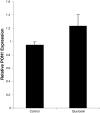Is alcohol beneficial or harmful for cardioprotection?
- PMID: 20012900
- PMCID: PMC2885161
- DOI: 10.1007/s12263-009-0161-2
Is alcohol beneficial or harmful for cardioprotection?
Abstract
While the effects of chronic ethanol consumption on liver have been well studied and documented, its effect on the cardiovascular system is bimodal. Thus, moderate drinking in many population studies is related to lower prevalence of coronary artery disease (CAD). In contrast, heavy drinking correlates with higher prevalence of CAD. In several other studies of cardiovascular mortalities, abstainers and heavy drinkers are at higher risk than light or moderate drinkers. The composite of this disparate relation in several population studies of cardiovascular mortality has been a "U-" or "J-"shaped curve. Apart from its ability to eliminate cholesterol from the intima of the arteries by reverse cholesterol transport, another major mechanism by which HDL may have this cardioprotective property is by virtue of the ability of its component enzyme paraoxonase1 (PON1) to inhibit LDL oxidation and/or inactivate OxLDL. Therefore, PON1 plays a central role in the disposal of OxLDL and thus is antiatherogenic. Furthermore, PON1 is a multifunctional antioxidant enzyme that can also detoxify the homocysteine metabolite, homocysteine thiolactone (HTL), which can pathologically cause protein damage by homocysteinylation of the lysine residues, thereby leading to atherosclerosis. We demonstrated that moderate alcohol up regulates liver PON1 gene expression and serum activity, whereas heavy alcohol consumption had the opposite effects in both animal models and in humans. The increase in PON1 activity in light drinkers was not due to preferential distribution of high PON1 genotype in this group. It is well known that wine consumption in several countries shows a remarkable inverse correlation to local rates of CAD mortality. Significantly, apart from its alcohol content, red wine also has polyphenols such as quercetin and resveratrol that are also known to have cardioprotective effects. We have shown that quercetin also up regulates PON1 gene in rats and in human liver cells. The action of quercetin seems to be mediated via the active form of the nuclear lipogenic transcription factor, sterol-regulatory element-binding protein 2 (SREBP2) that is translocated from endoplasmic reticulum to the nucleus. However, the mechanism of action of ethanol-mediated up-regulation of PON1 gene remains to be elucidated. We conclude that both moderate ethanol and quercetin, the two major components of red wine, exhibit cardioprotective properties via the up-regulation of the antiatherogenic gene PON1.
Figures


Similar articles
-
Quercetin up-regulates paraoxonase 1 gene expression via sterol regulatory element binding protein 2 that translocates from the endoplasmic reticulum to the nucleus where it specifically interacts with sterol responsive element-like sequence in paraoxonase 1 promoter in HuH7 liver cells.Metabolism. 2010 Sep;59(9):1372-8. doi: 10.1016/j.metabol.2009.12.025. Metabolism. 2010. PMID: 20728021
-
Quercetin and ethanol attenuate the progression of atherosclerotic plaques with concomitant up regulation of paraoxonase1 (PON1) gene expression and PON1 activity in LDLR-/- mice.Alcohol Clin Exp Res. 2010 Sep 1;34(9):1535-42. doi: 10.1111/j.1530-0277.2010.01238.x. Epub 2010 Jun 25. Alcohol Clin Exp Res. 2010. PMID: 20586760 Free PMC article.
-
The role of 'paraoxonase-1 activity' as an antioxidant in coronary artery diseases.J Clin Diagn Res. 2013 Jul;7(7):1284-7. doi: 10.7860/JCDR/2013/5144.3118. Epub 2013 Jul 1. J Clin Diagn Res. 2013. PMID: 23998046 Free PMC article.
-
Moderate red wine consumption and cardiovascular disease risk: beyond the "French paradox".Semin Thromb Hemost. 2010 Feb;36(1):59-70. doi: 10.1055/s-0030-1248725. Epub 2010 Apr 13. Semin Thromb Hemost. 2010. PMID: 20391297 Review.
-
Paraoxonase, a cardioprotective enzyme: continuing issues.Curr Opin Lipidol. 2004 Jun;15(3):261-7. doi: 10.1097/00041433-200406000-00005. Curr Opin Lipidol. 2004. PMID: 15166781 Review.
Cited by
-
Plasma protein biomarkers of hepatocellular carcinoma in HCV-infected alcoholic patients with cirrhosis.PLoS One. 2015 Mar 19;10(3):e0118527. doi: 10.1371/journal.pone.0118527. eCollection 2015. PLoS One. 2015. PMID: 25789864 Free PMC article.
-
Low HDL cholesterol is associated with increased atherogenic lipoproteins and insulin resistance in women classified with metabolic syndrome.Nutr Res Pract. 2010 Dec;4(6):492-8. doi: 10.4162/nrp.2010.4.6.492. Epub 2010 Dec 28. Nutr Res Pract. 2010. PMID: 21286407 Free PMC article.
-
Alcohol, stem cells and cancer.Genes Cancer. 2017 Sep;8(9-10):695-700. doi: 10.18632/genesandcancer.156. Genes Cancer. 2017. PMID: 29234487 Free PMC article. Review.
-
Focus on: The cardiovascular system: what did we learn from the French (Paradox)?Alcohol Res Health. 2010;33(1-2):76-86. Alcohol Res Health. 2010. PMID: 23579938 Free PMC article. Review.
-
Cardioprotective effects of red wine and vodka in a model of endothelial dysfunction.J Surg Res. 2012 Dec;178(2):586-92. doi: 10.1016/j.jss.2012.06.009. Epub 2012 Jun 21. J Surg Res. 2012. PMID: 22748601 Free PMC article.
References
-
- Gunzerath L, Faden V, Zakhari S, Warren K. National Institutes on alcohol abuse and alcoholism report on moderate drinking. Alcohol Clin Exp Res. 2004;28(6):829–847. - PubMed
LinkOut - more resources
Full Text Sources
Miscellaneous
